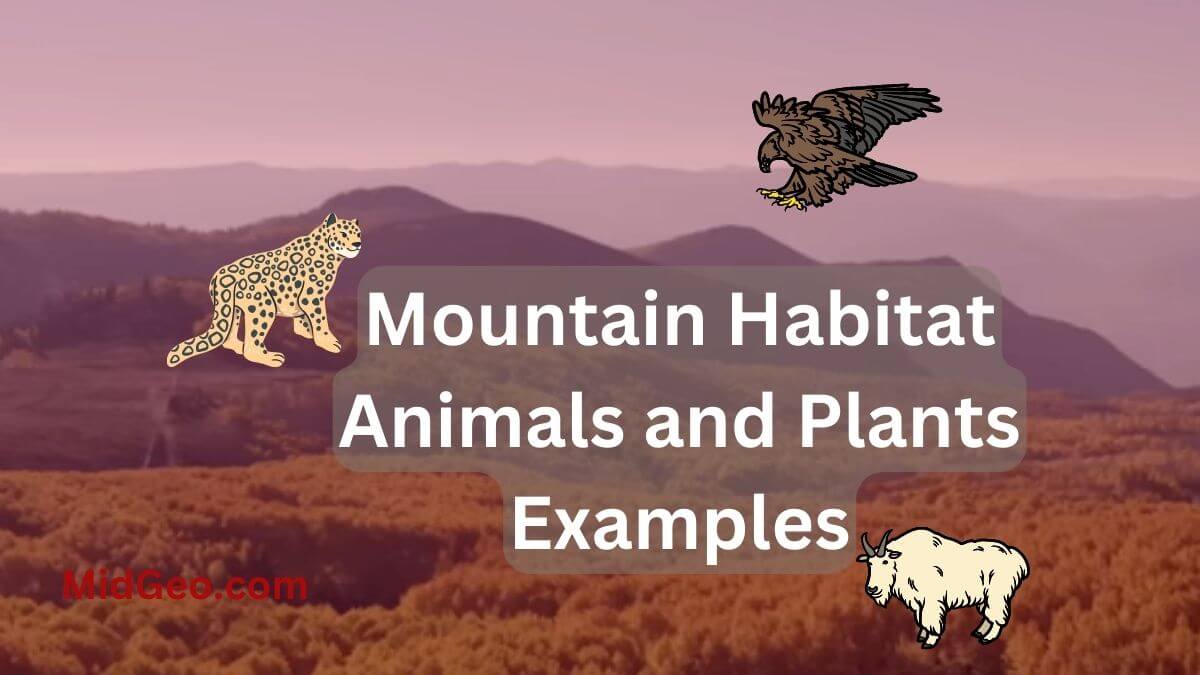Mountain Habitat Animals and Plants Examples

Mountain Habitat Animals and Plants: Mountains are a type of biome characterized by steep slopes, rocky terrain, and cold temperatures. These environments are home to a wide variety of animal and plant species that have adapted to the challenging conditions of mountain habitats.
In this article, we’ll explore some of the animals and plants that are found in mountain habitats, and we’ll also discuss the mountain habitat characteristics, examples, mountain biome, and grassland habitat.
Read Also: What are Landforms? Substantial Types of Landforms, Formation, Example
Mountain Habitat Examples
Content Summery
Mountain habitats are found all over the world, from the high peaks of the Himalayas to the rugged ranges of the Rockies. Here are some mountain habitat examples:
- Rocky Mountains: This mountain range spans over 3,000 miles from Canada to New Mexico and is home to a diverse range of animal and plant species, such as bighorn sheep, elk, and Douglas-fir trees.
- Andes Mountains: This mountain range is the longest in the world, stretching over 4,300 miles along the western coast of South America. It is home to a variety of species, including the Andean condor, vicuña, and quinoa plant.
- Alps: This mountain range spans over eight countries in Europe and is characterized by its towering peaks and vast glaciers. It is home to species such as the Alpine ibex, chamois, and Edelweiss flower.
Mountain Habitat Characteristics
Mountain habitats are known for their unique characteristics, which make them distinct from other biomes. Some of the most notable mountain habitat characteristics include:
- High altitude: Mountains are characterized by their high altitude, which creates colder temperatures, thinner air, and lower atmospheric pressure.
- Rocky terrain: Mountains are often characterized by their rugged, rocky terrain, which can make it difficult for plants and animals to survive.
- Precipitation: Mountains often receive high levels of precipitation, either in the form of snow or rain, which can create unique ecosystems and habitats.
Mountain Habitat Animals and Plants

Mountains are breathtaking features of nature that rise high above the surrounding landscapes. These rocky habitats are characterized by steep slopes, extreme temperatures, and high altitudes, making them one of the most challenging environments for animal and plant life. Despite the harsh conditions, a diverse range of flora and fauna have adapted to thrive in these high-altitude ecosystems.
Here, We will explore some of the unique animals and plants that call mountain habitats home.
Mountain Habitats Animals
Mountain habitats are home to a diverse range of animal species, many of which are found nowhere else on earth. Here are some of the most common animals that inhabit mountain ecosystems:
- Mountain goats: These nimble creatures are well adapted to life on steep mountain slopes. Their hooves have soft, rubbery pads that help them grip the rocky terrain, and they have powerful leg muscles that allow them to leap from ledge to ledge with ease.
- Snow leopards: These elusive predators are among the most endangered big cats in the world. They are perfectly adapted to life in the cold, high-altitude environments of the Himalayas, where they hunt mountain goats, bharal (a type of wild sheep), and other prey.
- Golden eagles: These birds of prey are known for their impressive hunting skills and keen eyesight. They are often seen soaring above mountain ranges, searching for prey such as rabbits, hares, and small mammals.
- Pika: These small, furry rodents are found in mountain habitats all over the world. They are well adapted to life in cold environments, and they spend much of their time gathering food to store for the winter months.
Mountain Habitats Plants
Mountain habitats are also home to a wide variety of plant species that have adapted to the challenging conditions of these environments. Here are some of the most common plants that are found in mountain ecosystems:
- Alpine tundra: This type of vegetation is found at high altitudes above the tree line. It is characterized by low-growing, hardy plants that are adapted to the harsh conditions of mountain habitats. Examples include arctic moss, lichens, and dwarf shrubs.
- Coniferous forests: These forests are found on the lower slopes of mountains, where the climate is milder. They are dominated by trees such as spruce, pine, and fir, which are well adapted to the cold temperatures and rocky terrain of mountain habitats.
- Wildflowers: Mountain habitats are known for their stunning displays of wildflowers, which bloom in the spring and summer months. Examples include columbine, lupine, and Indian paintbrush, which are well adapted to the cold, rocky soil of mountain environments.
- What is a Beach? How Are Beaches Formed?
- List of Landforms A to Z on Earth
- Which Land Feature Supports the Theory of Continental Drift?
- How are Sedimentary Rocks Formed: Understanding the Formation Process
- Why is a Delta Often Used as an Agricultural Area?
Mountain Biome
The mountain biome is one of the world’s largest and most diverse biomes, encompassing a wide range of different mountain ecosystems. The mountain biome is characterized by its high altitude, cold temperatures, and rugged terrain. Some of the most common animals and plants found in mountain biomes include:
Mountain goats and sheep: These animals are well adapted to life in rocky mountain environments and are able to climb steep slopes with ease.
Coniferous trees: Trees such as spruce, pine, and fir are common in mountain biomes, as they are well adapted to the cold temperatures and rocky terrain.
Alpine flowers: Mountain biomes are known for their stunning displays of wildflowers, such as lupine, columbine, and Indian paintbrush.
Grassland Habitat
While mountains are often associated with rocky terrain and cold temperatures, some mountain habitats are actually characterized by grassland habitats. These grasslands are often found on the lower slopes of mountains and are home to a variety of grasses and wildflowers. Some examples of grassland habitats in mountain ecosystems include:
- Alpine meadows: These grassy areas are found at high altitudes and are home to a variety of wildflowers and grasses.
- Montane grasslands: These grasslands are found on the lower slopes of mountains and are characterized by their open spaces and diversity of plant and animal species.
Mountain habitats are some of the most unique and challenging environments on earth. From the rugged terrain to the cold temperatures, these ecosystems present a range of challenges to the animals and plants that inhabit them. By exploring mountain habitat examples and understanding the mountain habitat characteristics, we can gain a greater appreciation for the incredible diversity of life on our planet.




